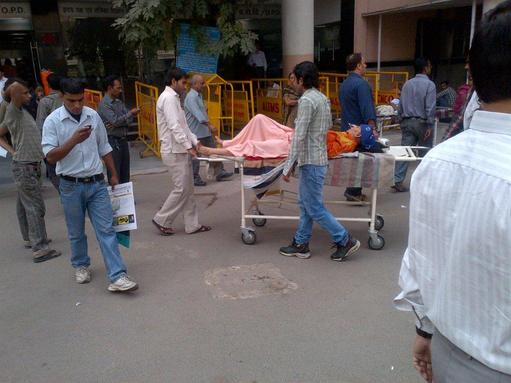Directory

Henry Dowlen
Surgeon LieutenantHenry works as a Doctor in Emergency Medicine, and as a National Lead for Health Informatics. He has served with the Royal Navy and Royal Marines, mainly concentrated in Afghanistan where he worked alongside the Afghan Government in assisting the reconstruction of community medical provision. He is currently a Deployable Civilian Expert for the UK's Stabilisation Unit and an officer in the Royal Marines Reserves.
view this profile
All of my videos about the conference.
go to cluster
Alan Gelb
Senior Fellow, Center for Global DevelopmentDirectory:
Expertise:
Alan Gelb is a senior fellow at the Center for Global Development. His recent research includes aid and development outcomes, the transition from planned to market economies, the development applications of biometric ID technology, and the special development challenges of resource-rich countries. He was previously director of development policy at the World Bank and chief economist for the bank’s Africa region and staff director for the 1996 World Development Report “From Plan to Market.
view this profile

Mike Farrar
Independent management consultantDirectory:
Expertise:
Mike Farrar is an independent management consultant and former Chief Executive of the NHS Confederation. He joined the organisation in May 2011.
Mike was chief executive of the North West England SHA from May 2006 to April 2011. He was previously chief executive of West Yorkshire and South Yorkshire Strategic Health Authorities, chief executive of Tees Valley Health Authority and head of primary care at the Department of Health.
Mike was also a board member of Sport England, and in August 2009 was appointed as National Tsar for Sport and Health. Mike was also awarded the CBE in 2005 for services to the NHS and is an honorary fellow of the University of Central Lancashire.
view this profile

Michael Marmot
Professor of Epidemiology and Public Health at University College, London and Director of the UCL Institute of Health EquityDirectory:
Expertise:
Sir Michael Marmot is Professor of Epidemiology and Public Health at University College, London and Director of the Institute of Health Equity (UCL Department of Epidemiology & Public Health).
Professor Marmot has been awarded honorary doctorates from 14 universities and has led research groups on health inequalities for 40 years. He was Chair of the Commission on Social Determinants of Health (CSDH), which was set up by the World Health Organization in 2005, and produced the report entitled: ‘Closing the Gap in a Generation’ in August 2008.
At the request of the British Government, he conducted the Strategic Review of Health Inequalities in England, which published its report 'Fair Society, Healthy Lives' (aka The Marmot Review) in February 2010. This was followed by the European Review of Social Determinants of Health and the Health Divide, for WHO Europe in 2014. He chaired the Breast Screening Review for the NHS National Cancer Action Team and from 2011-2004 was a member of The Lancet-University of Oslo Commission on Global Governance for Health. He is currently Chair of the PAHO Commission on Equity and Health Inequalities in the Region of the Americas.
He set up the Whitehall II Studies of British Civil Servants, investigating explanations for the striking inverse social gradient in morbidity and mortality. He leads the English Longitudinal Study of Ageing (ELSA) and is engaged in several international research efforts on the social determinants of health. He served as President of the British Medical Association (BMA) in 2010-2011, and President of the World Medical Association (2015-16) and he is President of the British Lung Foundation. He is an Honorary Fellow of the American College of Epidemiology, a Fellow of the Academy of Medical Sciences, an Honorary Fellow of the British Academy, and an Honorary Fellow of the Faculty of Public Health of the Royal College of Physicians. He was a member of the Royal Commission on Environmental Pollution for six years and in 2000 he was knighted by Her Majesty The Queen, for services to epidemiology and the understanding of health inequalities.
Internationally acclaimed, Professor Marmot is a Foreign Associate Member of the Institute of Medicine (IOM), and a former Vice President of the Academia Europaea. He won the Balzan Prize for Epidemiology in 2004, gave the Harveian Oration in 2006, and won the William B. Graham Prize for Health Services Research in 2008.
view this profile
How do you develop a patient centred healthcare system that serves vast numbers of transient poor people? India has an answer: Rashtriya Swasthya Bima Yojna (RSBY), which has won plaudits from the World Bank and the United Nations as one of the world's best health insurance schemes.
RSBY combines state-of-the-art technology and incentive structures. It is paperless, does not use cash and provides affordable health insurance to millions of people. The overwhelming majority of who, are illiterate, transient people living below the poverty line.
RSBY employs cost effective, scalable technologies to help satisfy the health needs of a significant proportion of India’s poor. Enrolment of families into the scheme, biometric smart card generation, pre-authorization of admissions, as well as claim submission and approval, all occur electronically. Beneficiaries can use their smartcards in any empanelled hospital across India and therefore travel is no barrier to receiving healthcare. Patient data are transferred electronically between empanelled hospitals and insurance companies and claims are settled automatically. The scheme lowers costs, increases efficiency and reduces fraud.

|
|
|

|
|
|

Is it possible for doctors to provide care without being perceived as taking sides during conflicts? This question is posed more and more as attacks on health workers in war zones increase.
In January 2012, Khalil Rashid Dale, a doctor travelling in a clearly marked International Committee of the Red Cross (ICRC) vehicle to Quetta, the capital of Baluchistan province in Pakistan, was abducted by unknown armed men. Some four months later the doctor’s beheaded body was found in an orchard. Also in January two Médicins Sans Frontières (MSF) health workers were killed in Mogadishu, Somalia. The consequences of such attacks are disproportionate in their impact. A consequence of the Somalia killings led to the MSF closing two 120-bed medical facilities in Mogadishu, which served a population of some 200,000 and which over the previous year, had treated close to 12,000 malnourished children and provided measles’ vaccinations and treatment to another 68,000 patients.
In 2011 Robin Coupland, a former trauma surgeon, now a medical adviser with the ICRC, co-authored Health Care in Danger, a study, which describes how and why health workers get caught in the cross fire and what the consequences are when they do. The study was used to launch an ICRC campaign to raise awareness of the problem and make a difference to health workers on the ground.
For some people however, it is impossible for doctors to provide care without being perceived as taking sides during conflicts. Some argue that as the quantum of humanitarian aid has increased over the past decade, so humanitarian aid agencies have been compelled to rely on sub-contracting in actual conflict areas. This, it is suggested, provides a breeding ground for aid corruption to finance nefarious elites and to further destabilize conflict areas, implying that healthcare activities of humanitarian organisations in war-torn regions have become increasingly politicised. Even agencies that make considerable efforts to disassociate themselves from political actors and project an image of neutrality have not been immune from attack.
Do warring factions perceive health workers as supporting the enemy and therefore see them as legitimate targets? Or are health workers targeted because they represent an opportunity to amplify messages to a global audience? It is likely both are true, but the impact on society as a result of removing vital healthcare in war zones, due to these attacks, can have devastating consequences.

|
How do you develop a patient centred healthcare system that serves vast numbers of transient poor people? India has an answer: Rashtriya Swasthya Bima Yojna (RSBY), which has won plaudits from the World Bank and the United Nations as one of the world's best health insurance schemes. RSBY combines state-of-the-art technology and incentive structures. It is paperless, does not use cash and provides affordable health insurance to millions of people. The overwhelming majority of who, are illiterate, transient people living below the poverty line. According to Dr Anshuman Kumar, Chief Oncosurgeon, Dharamshila Cancer Hospital and Research Centre in New Delhi, “Since its launch, four years ago, Rashtriya Swasthya Bima Yojna covers some 40 million people many of whom have benefitted from in-patient hospital procedures. The scheme has been so successful that the Government is planning to extend it to India’s old age and disabled pension schemes”. In developing countries, poverty and ill health are synonymous. Billions of poor people lack access to healthcare while being exposed to multiple health risks. This, not only increases the health consequences for those individuals and their families, but has both a direct and indirect effect on economies. Widespread poverty as well as ill health decreases productivity; lowers competiveness, increases fiscal pressure, creates further poverty and promotes greater inequity. India is a rising global economic superpower with a GDP roughly equivalent to 3% of the world economy, but has a third of the world’s poor. In 2011 the World Bank reported that 33% of India’s population fell below the international poverty line of US$1.25 per day and 69% live on less than US$2 per day. Although India is on track to meet its poverty reduction goal set by the United Nations in 2000; by 2015, 53 million people are expected to be still living in extreme poverty and 24% of India’s population of 1.2 billion is expected to be still living on less than US$1.25 per day. India is not unique in being a rich country with poor people. This is a phenomenon shared by several developing countries. For example, Mozambique, rich in gas, oil and minerals, is a fast growing rich country with poor people. Ninety nine per cent of Mozambicans are small scale farmers and a large proportion of these are poor. Mega projects, such as the planned US$6 billion investment by Vale, a Brazilian company, to create the world’s largest coal mine in Mozambique, do not generate large numbers of jobs, do not foster entrepreneurship and because of the tax incentives they receive, only make modest contributions to exchequers. African rich countries with poor people might do well to look to India’s RSBY health insurance scheme. Like many fast growing developing economies, India needs to fuel economic growth by reducing the percentage of poor and reaping the benefit from her working age population. India’s declining fertility and mortality rates have resulted in a population bulge of about 0.45 billion people between the ages of 15 and 25 years. This gives India the world’s largest share of working age population: a demographic dividend. But, how does India finance and provide healthcare for this vast group, a third of which are illiterate, transient and live below the poverty line? The answer is RSBY. RSBY employs cost effective, scalable technologies to help satisfy the health needs of a significant proportion of India’s poor. Enrolment of families into the scheme, biometric smart card generation, pre-authorization of admissions, as well as claim submission and approval, all occur electronically. Beneficiaries can use their smartcards in any empanelled hospital across India and therefore travel is no barrier to receiving healthcare. Patient data are transferred electronically between empanelled hospitals and insurance companies and claims are settled automatically. The scheme lowers costs, increases efficiency and reduces fraud. RSBY is run on shared financial contributions by both central and state governments. Seventy five per cent of the premium is borne by the central government and the rest by state governments and all parties involved benefit. The Indian Government benefits by providing cost effective healthcare to millions of poor people. This helps to reduce poverty and increase productivity. Insurers benefit because they are paid for each household they recruit. Empanelled hospitals benefit as they are incentivised to provide treatment to a large number of participants. Non government agencies benefit because they are paid to find and recruit households. Poor people benefit because the scheme transforms them into customers and provides them access to healthcare, which they never had before. |
|
Beneficiaries receive hospitalization coverage up to US$560 per year for some 700 in-patient procedures. Central and state governments pay the premium to insurers who are selected by state governments on the basis of competitive bidding. Insurers monitor participating hospitals, which reduces unnecessary procedures and fraud. Beneficiaries need only pay about US$0.75 as an annual registration fee. The scheme has no age limit, it covers pre-existing ailments, provides surgical and health expenses for five family members and covers pre and post hospitalization charges and transport expenses of US$2 per visit. RSBY’s has its challenges. There are human rights issues associated with biometric identification and the digitalisation and use of confidential personnel data. There have been delays in the issuance of smart cards. Some people have complained that they do not know how and where to utilise the scheme. Some hospital personnel have not been appropriately trained to use card-reading technology and there have been delays in the reimbursement of treatment expenses to hospitals and some hospitals stopped accepting patients under the scheme. On 12th October 2012, the Times of India reported: “Privatehospitals are reportedly milking Rashtriya Swasthya Bima Yojnaby carrying out fictitious or unnecessary surgical procedures on poor patients covered under the scheme. . . . . . When payers do not have a tight supervisory mechanism or do not care since the government is footing the bill, ultimately, hospitals get away with murder. The right thing to do is to align incentives, not put more constables on the hospital watch.” India is not known for its good governance, especially among public officials, but challenges encountered by RSBY should not detract from the importance of this innovative and ambitious scheme.
Healthcare systems throughout the world are challenged by rising costs, poor quality of care and inaccessibility to healthcare. Healthcare systems will become unsustainable if they continue to focus on diseases rather than patients. Patient-centred care has become one of the principal goals of health advocacy. RSBY, based on digital technologies, makes patients the primary focus of the system and individuals are helped to self manage their conditions. It is not surprising that last summer a delegation of policy makers from Germany, Europe’s industrial powerhouse, spent time in India learning more about RSBY with the intent of changing Germany’s social security systems. Policy makers from rich countries with poor people might think of doing something similar. |




